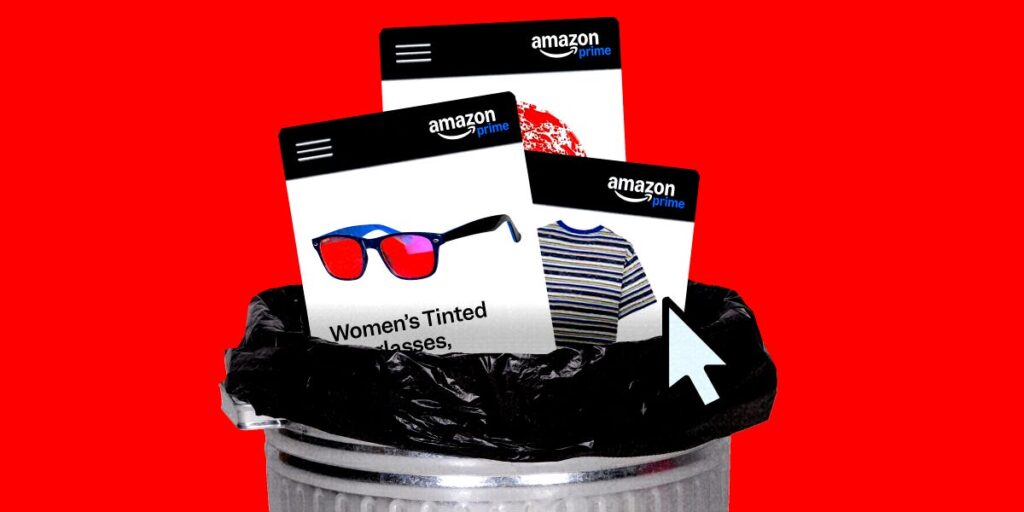Call it an “Everything Store,” just without the clutter.
Amazon has been getting rid of billions of product listings deemed “unproductive” through a confidential project called “Bend the Curve,” according to an internal planning document obtained by Business Insider.
The document reveals that Amazon planned to remove at least 24 billion ASINs, or unique product listings, from its marketplace. These underperforming items range from poor-selling items to those with misleading descriptions or inactive pages.
“Reduce active ASINs in the Amazon Catalog to be less than 50B (projected to be 74B by EOY 2024) by cleaning up unproductive selection,” the document stated, giving a deadline of December 2024.
Bend the Curve is part of a broader cost-cutting strategy led by CEO Andy Jassy, who took the helm in 2021. Eliminating billions of product listings helps Amazon’s retail business control cloud costs as it doesn’t have to host as many product pages online.
The initiative is notable for Amazon, which has spent 3 decades relentlessly expanding its product catalog in pursuit of a limitless online marketplace — a strategy that earned it the nickname “The Everything Store.”
Amazon is still growing its vast selection, but the company is putting more focus on removing low-performing or inaccurate listings in favor of a more streamlined and effective catalog.
Striking a tricky balance
Having almost infinite selection means shoppers are more likely to find what they’re looking for on Amazon, increasing the chances they buy something, and return again. That’s been a powerful advantage over physical retail stores, which can only stock so much.
Amazon is highly unlikely to give up the benefits of this massive product selection. However, some of the company’s digital aisles have become cluttered and outdated in recent years, which could confuse or frustrate shoppers.
Striking a balance between these two goals could be tricky, and Bend the Curve has been hotly debated internally, according to a person familiar with the project.
Some Amazon shoppers may already be noticing. According to Evercore ISI’s annual online retail survey, fewer respondents believe Amazon offers the best product selection.
In 2022, a record-high 84% of respondents gave Amazon top marks for selection. That figure fell to 79% in 2023, and declined further to 68% last year, marking a record low in the survey’s 12-year history.
“Phasing out items”
In an email to BI, Amazon’s spokesperson said the company will continue to expand its active product listings. The initiative is intended to clean up data, not curtail selection, the spokesperson said, adding Amazon added millions of new items to its product catalog last year.
“We have a cost-reduction initiative in place to remove unhelpful data, including product listings that are inaccurate, incomplete, or in other ways fail to meet our listing requirements,” the spokesperson told BI. “The aim is not to reduce active product listings.”
The number of “active ASINs” does not correspond exactly with the actual product selection visible to customers, and reducing that number doesn’t always equate to a reduction in selection. “Unproductive selection” includes items that can’t be purchased, for instance, if there’s no actual inventory to support a listing, or if product listings haven’t been updated for more than two years, the spokesperson explained.
“Our teams regularly review product listings based on performance, quality, and evolving customer needs — and we’ve done this for many years,” the spokesperson added. “In some cases, it may involve phasing out items that no longer meet our standards or are being replaced by newer versions. The goal is always to refine, not restrict, selection, ensuring our shopping experience meets the highest standards.”
The spokesperson added that there was “no debate in the sense of whether to proceed” with the Bend the Curve project.
“Leadership made clear throughout the process that the work should not, even by accident, negatively impact selling partners or remove selection from Amazon, and we put guardrails in place to ensure that didn’t happen,” the spokesperson added.
‘Throttling’ listings
For years, Amazon has simplified the process of becoming a seller on its platform. These third-party merchants are now responsible for more than 60% of all products sold on Amazon.
Amazon believes that growing the number of third-party sellers and expanding product selection fuel a flywheel: more choices lead to happier customers, attract more shoppers, and ultimately drive continued growth.
In Amazon’s 1999 shareholder letter, founder Jeff Bezos envisioned a place where people could “come to find and discover anything and everything they might want to buy online.”
However, Amazon’s drive to create a limitless aisle of products has come with challenges. The platform has faced issues with counterfeit goods, expired food items, and non-compliant products, leading to consumer complaints and regulatory scrutiny.
Amazon has taken many steps to tackle counterfeit goods in the past. And with Bend the Curve, Amazon is putting other controlling measures in place.
In 2024, Amazon launched a new “creation throttling” feature that blocks new product listings from some underperforming seller accounts, the internal document showed. The company targeted at least 12,000 active sellers with catalogs of more than 100,000 product listings and no sales in the previous 12 months as part of the program, according to the document.
This enforcement prevented more than 110 million new listings from being created, while nearly 3,000 sellers got warning messages for being close to the throttling threshold.
The document said some of the sellers exited enforcement by modifying their listings or increasing their sales. The initiative “promoted significant catalog cleanup,” it added.
Bend the Curve also led to confusion among some sellers regarding the policy’s scope. According to the document, only “unproductive” accounts were affected. However, some sellers with multiple accounts mistakenly believed that their entire accounts were being blocked from creating new listings.
In response, Amazon is focusing this year on more clearly “defining policy enforcement and communication” to avoid misunderstandings, the document said. The company is also analyzing deleted listings to determine if there are identifiable patterns.
‘Cost avoidance’
By removing or streamlining unproductive listings, Bend the Curve saved more than $22 million in AWS server costs in 2024, the document said. Amazon projected an additional $36 million in AWS server “cost avoidance” in 2025 as the initiative continues.
Amazon’s retail division expected to spend approximately $5.7 billion on AWS cloud infrastructure in 2025, a 27% increase from last year’s $4.5 billion, according to another internal planning document obtained by BI. That’s a slower growth rate compared to the previous year, when AWS server costs rose 36% from about $3.3 billion in 2023.
Have a tip? Contact this reporter via email at [email protected] or Signal, Telegram, or WhatsApp at 650-942-3061. Use a personal email address and a nonwork device; here’s our guide to sharing information securely.
Read the full article here
















